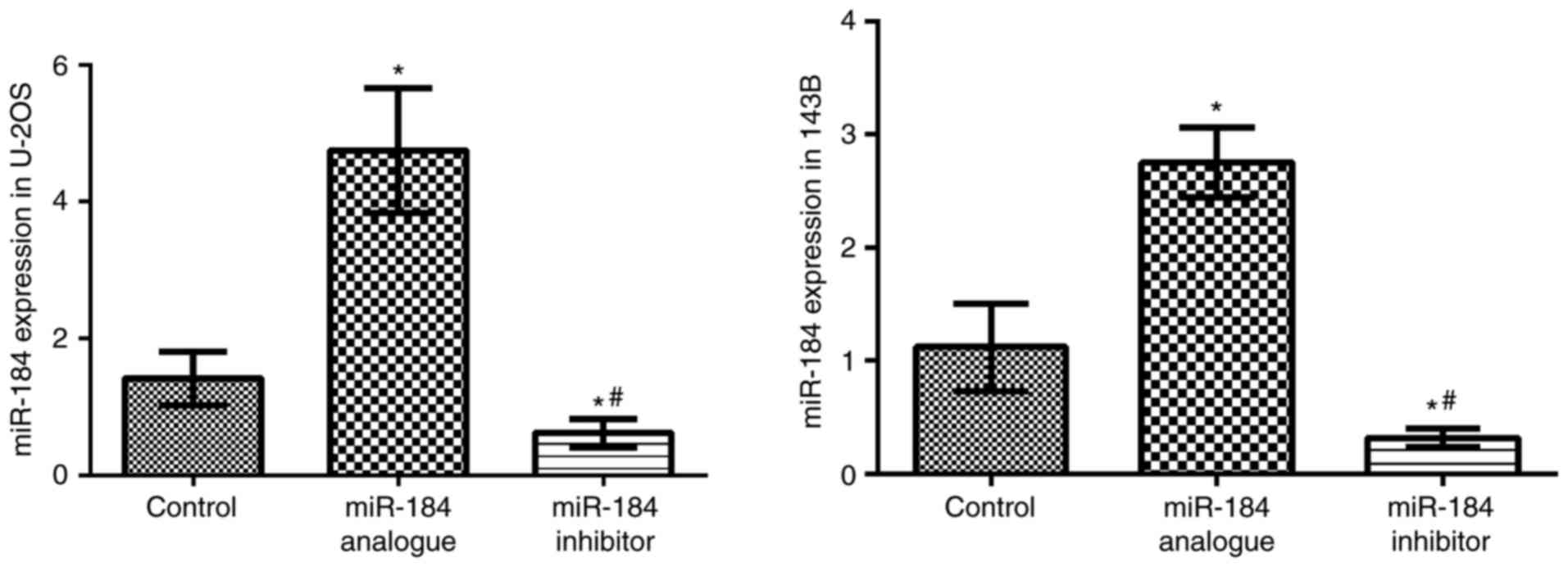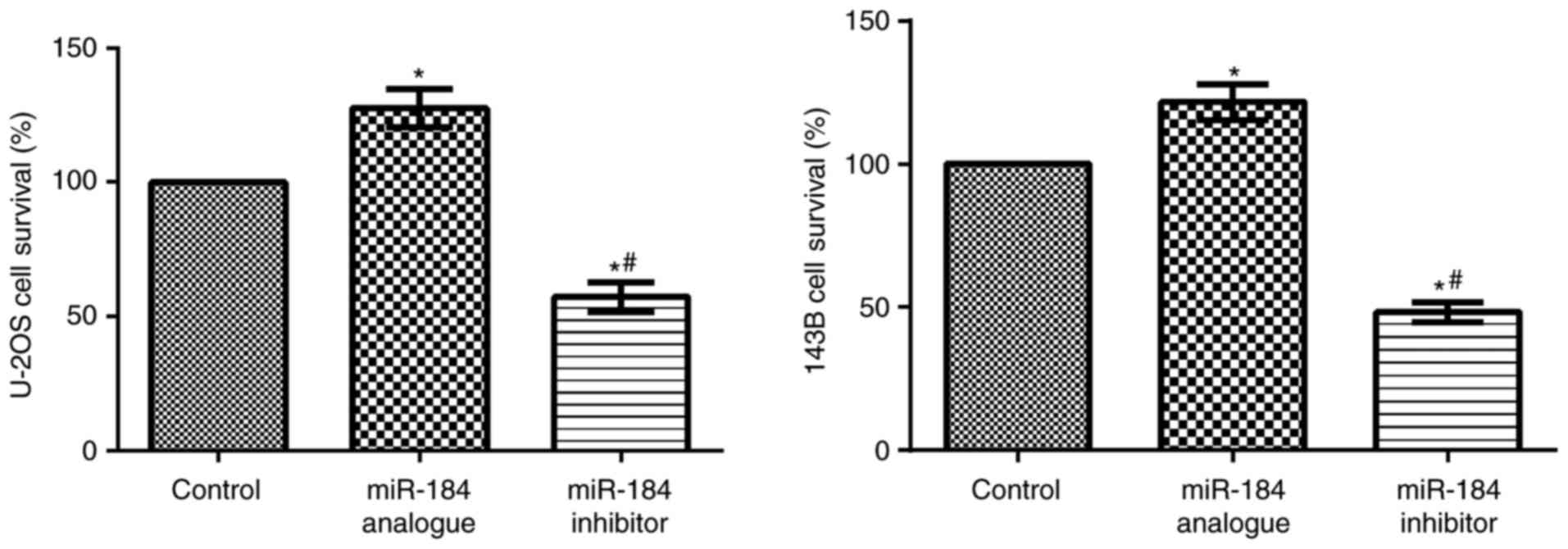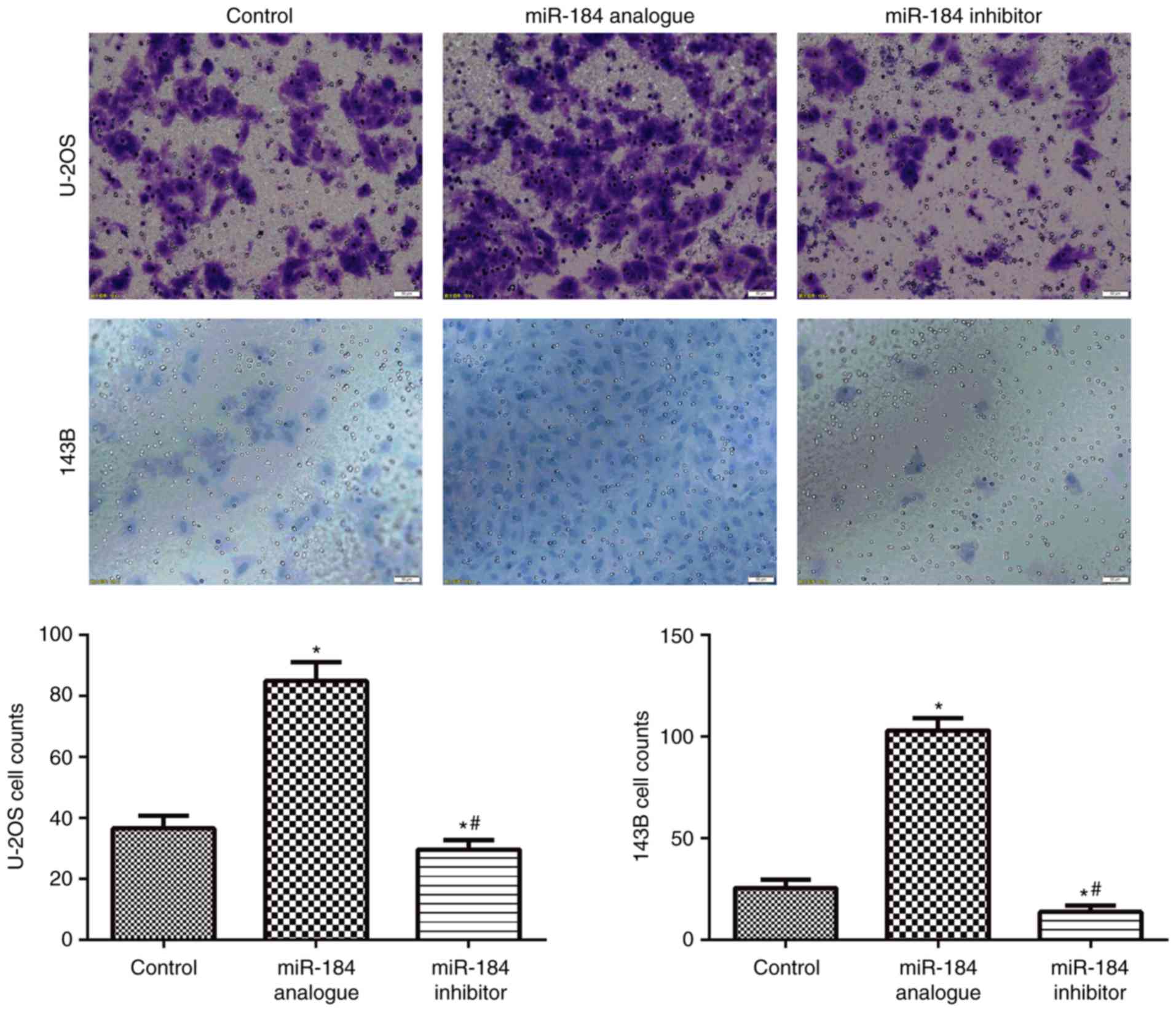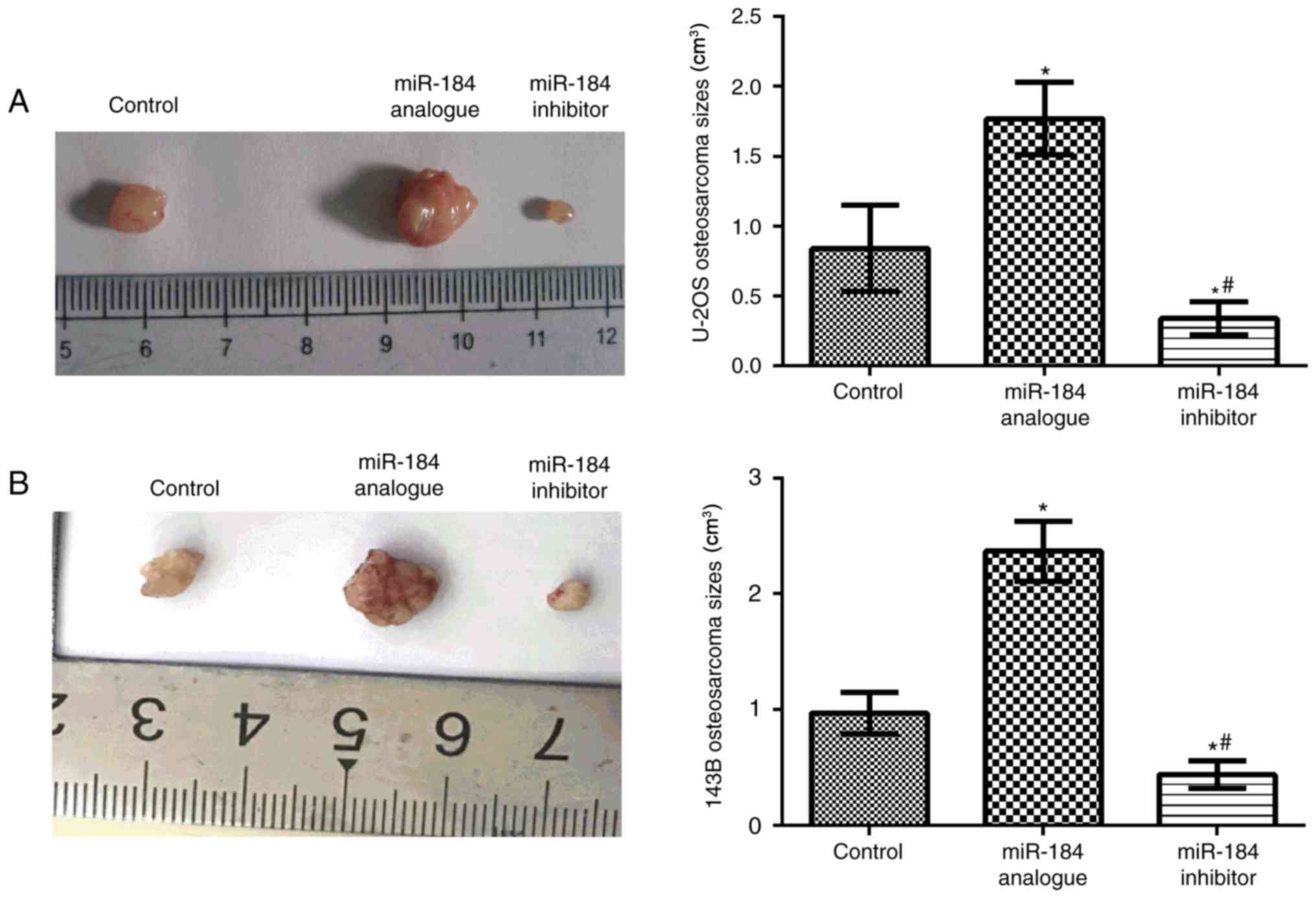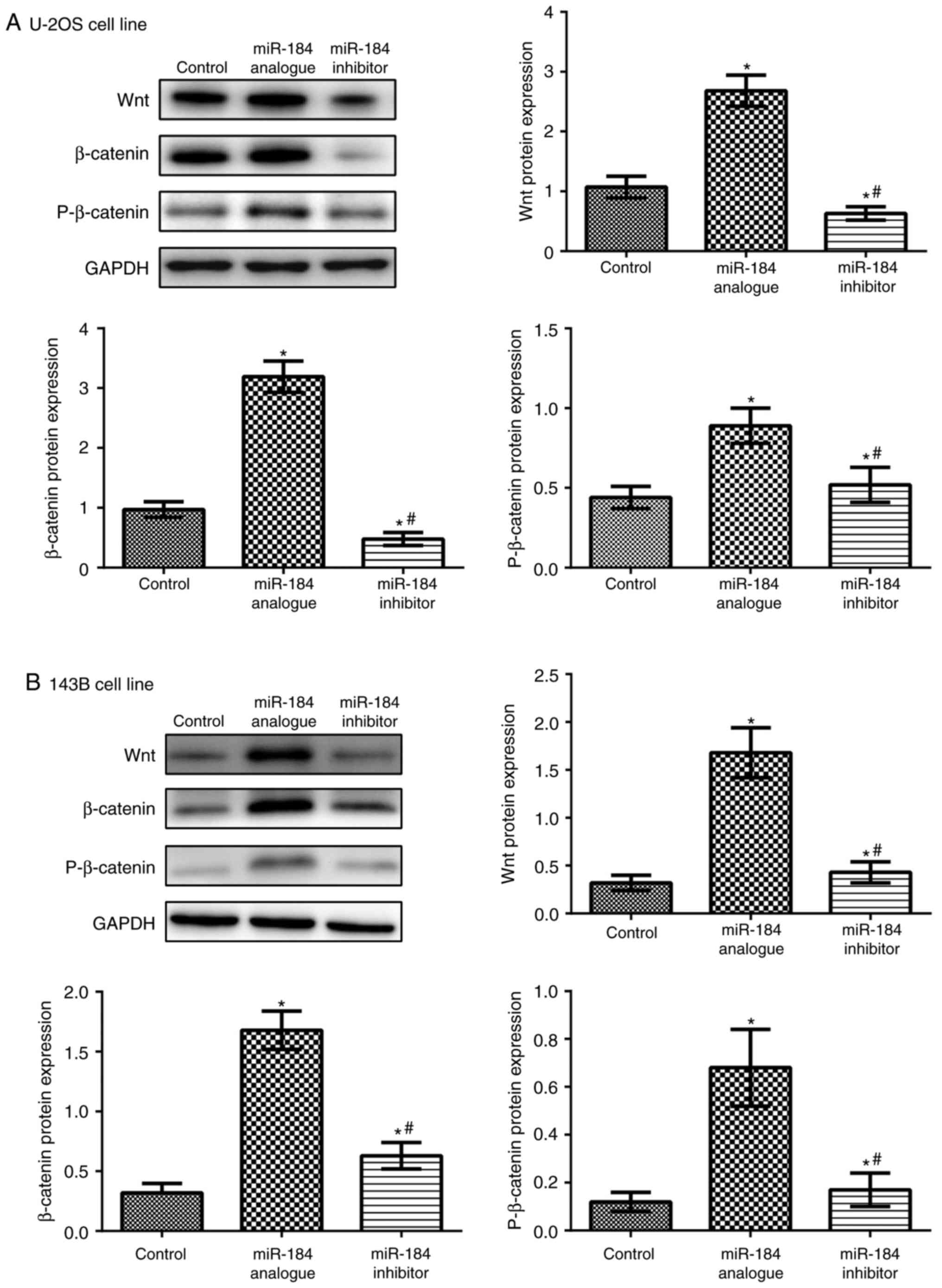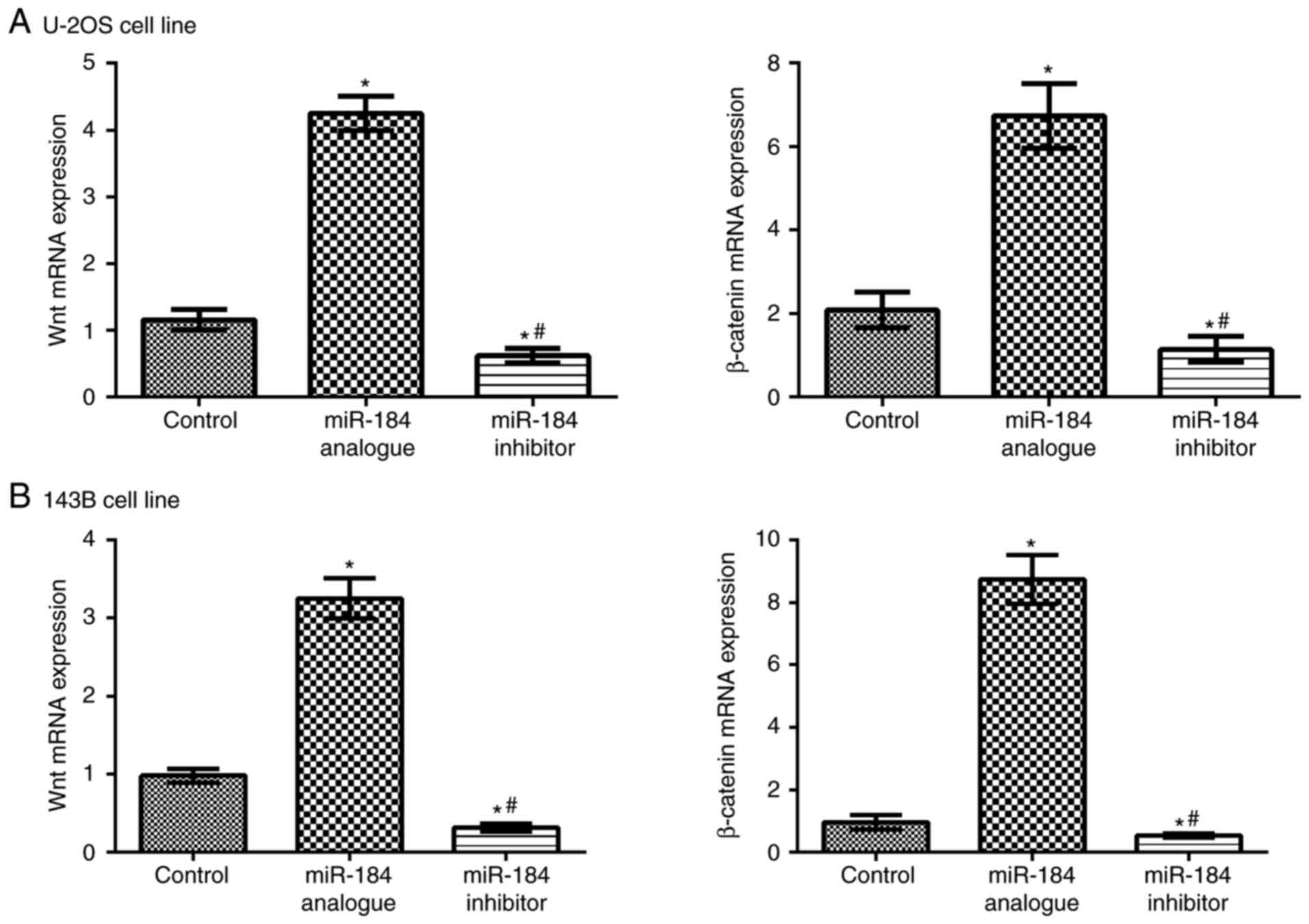Regulatory effects of microRNA‑184 on osteosarcoma via the Wnt/β‑catenin signaling pathway
- Authors:
- Published online on: June 18, 2018 https://doi.org/10.3892/mmr.2018.9184
- Pages: 1917-1924
-
Copyright: © Du et al. This is an open access article distributed under the terms of Creative Commons Attribution License.
Abstract
Introduction
Osteosarcoma is a common type of primary malignant bone tumor in children and adolescents (1). Previously, the treatment of osteosarcoma was primarily amputation; however, chemotherapeutic drugs containing Adriamycin, methotrexate, ifosfamide and cisplatin (2,3), surgery and radiotherapy have increased the 5-year survival rate of patients to ~70% (4). However, high local recurrence rate, early distant metastasis and poor chemotherapy sensitivity provide large mental and economic burdens to patients and their families (5). Therefore, it is important to investigate the molecular mechanism of biological activity of osteosarcoma.
A number of genes associated with tumor invasion and metastasis have been reported in the investigation into the occurrence, development and metastasis of osteosarcoma (6,7). In particular, the discovery of microRNA (miRNA) provides a novel direction for the study of osteosarcoma gene regulation. miRNA is a small non-coding RNA molecule (containing ~22 nucleotides), which inhibits the translation of target mRNA and is involved in the regulation of protein biosynthesis at the post-transcriptional level via the complete and incomplete complementation of the terminal 3′untranslated region of a downstream gene. A previous study demonstrated that ~3% of human genes encode miRNAs and >30% human genes may be regulated by miRNA (8). Abnormal miRNA structure or expression can cause the occurrence of tumors. Studies have revealed that a variety of miRNAs exert different effects as oncogenes or tumor suppressor genes on osteosarcoma; miR-32, miR-29b, miR-145 and miR-194 exhibit an inhibitory effect (9–13), but miR-27a and miR-128 exert promoting effects on tumor proliferation, metastasis and invasion (14,15). MiR-184, as a novel miRNA in recent years, exhibits abnormal expression in numerous tumors, including hepatocellular carcinoma (miR-184 functions as an oncogenic regulator in hepatocellular carcinoma) and renal cell carcinoma (microRNA-184 functions as tumor suppressor in renal cell carcinoma), and serves carcinogenic or anticancer roles (16–20). A recent study verified the promoting effect of miR-184 in proliferation and invasion of osteosarcoma, but the precise mechanism remains unknown (21).
The Wnt signaling pathways are a group of signal transduction pathways that transfer extracellular signals to cells (22). The Wnt/β-catenin signaling pathway is one of three Wnt signaling pathways and can phosphorylate disheveled (Dv1) protein in the cytoplasm by binding to Wnt proteins (23). Thus, β-catenin is free from the Axin/adenomatous polypolis coli/casein kinase 1α/glycogen synthase kinase 3 β/β-catenin complex, and enters into the nucleus, binds to transcription factor lymphoid enhancer-binding factor/T-cell factor in the nucleus, and finally activates downstream target genes c-Myc and cyclin D1 (24). Abnormal initiation of the Wnt/β-catenin signaling pathway may lead to unlimited cell proliferation, thereby leading to tumorigenesis (25). Activation of the Wnt signaling pathway regulates osteosarcoma invasion and metastasis (26), and interferes with Wnt/β-catenin signals and inhibits growth and metastasis of osteosarcoma cells (27). However, scholars have also reported opposing findings that the activation of Wnt/β-catenin signaling pathway suppresses osteosarcoma cell proliferation (28). MiRNA regulation of the Wnt/β-catenin signaling pathway contains two categories: Activation and inhibition, involving 29 miRNAs, including miR-344 and miR-181, as well as 18 miRNAs that inhibit the Wnt signaling pathway, including miR-148a and miR-496 (29). However, its mechanism in the occurrence and development of osteosarcoma remains unclear. The present study was designed to investigate the effects of miR-184 on osteosarcoma growth, development and metastasis, and to further explore the effect of miR-184 on proliferation, invasion and metastasis of osteosarcoma cells via regulation of the Wnt signaling pathway.
Materials and methods
Culture of human osteosarcoma U-2OS cells and 143B cells
Human osteosarcoma U-2OS cells and 143B cells were purchased from the Type Culture Collection of the Chinese Academy of Sciences (Shanghai, China). U-2OS cells were incubated with RPMI-1640 (Gibco; Thermo Fisher Scientific, Inc., Waltham, MA, USA), and 143B cells were incubated with Dulbecco's modified Eagle's medium (DMEM; Gibco; Thermo Fisher Scientific, Inc.) at 37°C in a 5% CO2 incubator. In addition, 0.25% EDTA-trypsin and PBS were purchased from Gibco (Thermo Fisher Scientific, Inc.).
MiR-184 transfection into U-2OS cells and 143B cells
MiR-184 analogue sequence, 5′-GGCAUUCUGUAUACAUCGGAG-3′ and miR-184 inhibitor sequence, 5′-GAUCGGAGGUGCAUUCUA-3′ were synthesized by Shanghai GenePharma Co., Ltd. (Shanghai, China) following the manufacturer's protocol. Lipofectamine® 2000 reagent (Invitrogen; Thermo Fisher Scientific, Inc.) was used for transfection. A total of 1×106 infection units/ml lentivirus (miR-184) were used for transfection. Cells were washed three times with PBS and incubated with RPMI-1640 and DMEM at 37°C in a 5% CO2 incubator for 6 h, and were then used for subsequent analysis. U-2OS and 143B cells transfected with empty vectors (Shanghai GenePharma Co., Ltd.) were used as control groups.
MiR-184 expression levels detected by reverse transcription-quantitative polymerase chain reaction (RT-qPCR) prior to and post-transfection
RNA was extracted from U-2OS and 143B cells using TRIzol reagent (Thermo Fisher Scientific, Inc.). To generate cDNA, RT was performed using a Mir-X™ miRNA First-Strand Synthesis kit (cat. no. 638313; Takara Biotechnology Co., Ltd., Dalian, China), according to the manufacturer's protocol. An SYBR-Green Master mix (RR820A; Takara Biotechnology Co., Ltd., Dalian, China) was used for qPCR. All primers were designed and synthesized with Primer Premier 6.0 (Premier Biosoft International, Palo Alto, CA, USA). Primer sequences were as follows: MiR-184 sense, 5′-TACGACTATGTGACCTGCCTG-3′ and antisense, 5′-TGGTTCAACTCTCCTTTCCA-3′; U6 (sequence unavailable). The reaction conditions were: 95°C for 30 sec, 95°C for 5 sec, 60°C for 30 sec, and the fluorescence signal was detected from 40 cycles. MiR-184 expression levels were calculated using the 2−ΔΔCq method (30). MiR-184 expression levels were detected in the control group, miR-184 analogue group and miR-184 inhibitor group.
Cell viability measured via an MTT assay
U-2OS cells and 143B cells in the logarithmic phase were seeded on a 96-well plate, 4,000 cells/well, at 37°C and 5% CO2 for 24 h. Until stable growth, cells were harvested at 12, 24 and 36 h. A total of 20 µl MTT (Sigma-Aldrich; Merck KGaA, Darmstadt, Germany) was added in each well for 4 h at 37°C. Following the removal of the medium, 100 µl dimethyl sulfoxide was added to each well (Sigma-Aldrich; Merck KGaA) and agitated at a low speed for 10 min. The absorbance value of each well was measured at 570 nm with a microplate reader. The effect on cell proliferation was determined in the control group, miR-184 analogue group and miR-184 inhibitor group. Experiments were conducted in triplicate and each group had six parallel wells.
Cell invasion detected by Transwell assay
A Transwell assay (Hyclone; GE Healthcare, Chicago, IL, USA) was used to detect cell invasion. The Transwell chamber polycarbonate film was coated with 100 µl diluted Matrigel. A total of 100 µl cell suspension and 200 µl serum-free RPMI-1640 (for U-2OS cells) and DMEM (for 143B cells) were added to the upper chamber. A total of 500 µl RPMI-1640 and DMEM containing 10% fetal bovine serum (Gibco; Thermo Fisher Scientific, Inc.) was added to the lower chamber. Following incubation for 24 and 48 h at 37°C, samples were fixed with anhydrous ethanol for 60 min at 4°C, stained with 0.1% crystal violet for 30 min at room temperature, and then analyzed with a microscope (NE950; Leica Microsystems, Inc., Buffalo Grove, IL, USA). A total of 5 fields of view were observed. The effect on cell invasion was determined in the control group, miR-184 analogue group and miR-184 inhibitor group. Experiments were performed in triplicate and the average value was calculated.
Animals
A total of 36, 4-week-old female Balb/c nude mice (23–25 g) were purchased from the Experimental Animal Department of China Medical University (Shenyang, China). Mice were provided with access to food and water ad libitum, and the housing conditions were as follows: A temperature of 20–26°C, a 40–70% relative humidity and a 12/12 h light/dark cycle. The present study was approved by the China Medical University Institutional Animal Care and Use Committee (IACUC no. 2016024).
Establishment of nude mouse models of tibial orthotopic metastasis from osteosarcoma
Osteosarcoma U-2OS cells and 143B cells in the logarithmic phase were used to establish nude mouse models of tibial orthotopic metastasis. A total of 36 nude mice were randomly assigned to six experimental groups (six mice per group): i) U-2OS cells transfected with empty vectors (control), ii) 143B cells transfected with empty vectors (control), iii) U-2OS cells transfected with miR-184 analogues, iv) 143B cells transfected with miR-184 analogues, v) U-2OS cells transfected with miR-184 inhibitors and vii) 143B cells transfected with miR-184 inhibitors. The cell density was 2×106/ml; 30 µl cell suspension was infused into the bone marrow cavity of the right proximal tibia of nude mice of each group. The growth of orthotopic metastatic tumor was observed following injection every other day for 28 days.
Tumor growth rate and tumor volume
A total of 2 weeks post-orthotopic transplantation, nude mice bearing tumors were anesthetized with 1% pentobarbital via intraperitoneal injection (45 mg/kg) and then euthanized by cervical dislocation. Following dissection, tumor growth and volume were grossly observed. The long and short diameters of the transplanted tumor were calculated, and tumor volume was calculated in each group according to Steel formula: V=1/2a × b × b (‘V’ represents the volume, ‘a’ represents the length, and ‘b’ represents the width) (31). Tumor volume was compared among different groups.
Analysis of expression levels of Wnt and β-catenin protein in tumor tissue via western blotting
Tumor tissue of nude mice with metastatic tumors was collected from the control groups, the miR-184 analogue group and the miR-184 inhibitor group. Total protein was extracted from tumor tissues using radioimmunoprecipitation assay lysate buffer (Thermo Fisher Scientific, Inc.) and a bicinchoninic acid kit (BD Biosciences) was used to quantify protein. Protein samples (20 µg) were subjected to 10% SDS-PAGE and then transferred onto polyvinylidene fluoride membranes. The membranes were blocked with 5% non-fat milk powder for 2 h at room temperature, and incubated with primary antibodies at 4°C overnight. Primary antibodies were as follows: Anti-Wnt (cat. no. ab15251; 1:1,000), anti-β-catenin (cat. no. ab32572; 1:3,000), anti-phosphorylated-β-catenin (cat. no. ab27798; 1:500) and anti-GAPDH (cat. no. ab181602; 1:1,000; all Abcam, Cambridge, UK). Secondary antibodies (cat. no. bs-0295G; 1:1,000; BIOSS, Beijing, China) were added and incubated with membranes at room temperature for 2 h. Samples were detected with enhanced chemiluminescence (Amersham; GE Healthcare). The gray value was measured using Quantity One software (version 4.62; Bio-Rad Laboratories, Inc., Hercules, CA, USA).
Expression levels of Wnt and β-catenin mRNA in tumor tissue of nude mice detected by RT-qPCR
RT-qPCR was employed to determine β-catenin mRNA expression levels in control groups, miR-184 analogue groups and miR-184 inhibitor groups. RNA was extracted from the tumor tissues using TRIzol reagent (Thermo Fisher Scientific, Inc.). cDNA was synthesized using a High-Capacity RNA-to-cDNA™ kit (Invitrogen; Thermo Fisher Scientific, Inc.). A SYBR® Premix Ex Taq™ II (cat. no. RR820A; Takara Biotechnology Co. Ltd.) qPCR kit was used for detection. All primers were designed and synthesized with Primer Premier 6.0 (Premier Biosoft International). Primer sequences were as follows: Wnt sense, 5′-CCCGACGCTTCGCTTGAAT-3′, and antisense, 5′-GACCGCTGGAGGTGCCATG-3′; β-catenin sense, 5′-GAGCTGCCATGTTCCCTGAG-3′ and antisense, 5′-CAGTTGTCAATTTGATTAAC-3′; and GAPDH sense, 5′-ATCTGGAGTTTACCGCTGG-3′ and anti-sense, 5′-TACCGATGTCTGGTAGACGAT-3′. The thermocycling conditions were as follows: Initial denaturation at 95°C for 30 sec; followed by 40 cycles of annealing and elongation at 95°C for 5 sec and 60°C for 30 sec. Wnt and β-catenin mRNA expression levels were quantitatively analyzed using the 2−ΔΔCq method (30).
Statistical analysis
Data were analyzed using SPSS 19.0 software (IBM Corp., Armonk, NY, USA). Measurement data are expressed as the mean ± standard deviation. Comparisons between groups were made using a Student's t-test (two-tailed) or analysis of variance with a Tukey's post hoc test or Kruskal-Wallis test. P<0.05 was considered to indicate a statistically significant difference.
Results
MiR-184 expression levels in U-2OS and 143B cell lines
MiR-184 analogue and inhibitor were transfected into U-2OS cells and 143B cells using Lipofectamine® 2000. RT-qPCR was applied to detect miR-184 expression levels. Compared with the control groups, miR-184 expression levels were significantly higher in the miR-184 analogue groups (P<0.05), but significantly lower in the miR-184 inhibitor groups (P<0.05; Fig. 1). This result suggests that miR184 was successfully transfected into both cell lines.
Effects of miR-184 on U-2OS and 143B cell viability
An MTT assay was used to determine cell proliferation. Compared with the control groups, U-2OS cell and 143B cell proliferation were significantly increased in the miR-184 analogue groups (P<0.05), but significantly reduced in the miR-184 inhibitor groups (P<0.05; Fig. 2). This result demonstrated that transfection with miR-184 enhances the stability of both cell lines.
Effects of miR-184 on U-2OS and 143B cell invasion
A Transwell assay was used to determine cell invasion ability. Compared with the control groups, cell invasion ability was significantly increased in the miR-184 analogue groups (P<0.05), but significantly reduced in the miR-184 inhibitor groups (P<0.05; Fig. 3). This result suggested that miR-184 enhances the invasion ability of U-2OS and 143B cells.
Effects of miR-184 on the growth of tibial orthotopic metastasis from osteosarcoma in nude mouse models
In vivo analysis demonstrated that compared with the control groups, tumor volume significantly increased in the miR-184 analogue groups in both cell lines (P<0.05), while tumor volume was significantly decreased within the miR-184 inhibitor groups (P<0.05; Fig. 4). These results suggested that miR-184 promotes tumor growth in nude mice.
Wnt and β-catenin protein expression levels in nude mouse models of tibial orthotopic metastasis from osteosarcoma as detected by western blotting
Compared with the control groups, Wnt, β-catenin and phosphorylated β-catenin levels were significantly increased in the miR-184 analogue groups in both cell lines (P<0.05), but significantly decreased in the miR-184 inhibitor groups (P<0.05; Fig. 5). These results demonstrated that miR-184 may positively regulate Wnt signaling pathway-associated protein expression levels. Furthermore, the results suggest that miR184 regulates the Wnt signaling pathway to promote tumor growth.
Wnt and β-catenin mRNA expression levels in nude mouse models of tibial orthotopic metastasis from osteosarcoma as measured by RT-qPCR
Wnt and β-catenin mRNA expression levels were determined in the metastatic tumors of nude mice in the control, miR-184 analogue and miR-184 inhibitor groups. Overexpressed miR-184 could significantly upregulate Wnt and β-catenin mRNA expression levels compared with the control groups (P<0.05). Following the inhibition of miR-184 expression, Wnt and β-catenin mRNA expression levels were significantly decreased compared with the control (P<0.05; Fig. 6). These findings indicated that miR-184 may positively regulate Wnt and β-catenin mRNA expression levels. These results further suggest that miR-184 promotes tumor growth via the regulation of the Wnt signaling pathway.
Discussion
Osteosarcoma is the most common type of malignant bone tumor, which is characterized by a high degree of malignancy, distant metastasis easily occurring in the early stage, and poor prognosis in adults, adolescents and children (32). It was recently reported that osteosarcoma accounts for 3–5% cases of cancer in children and adolescents, and the pathogenesis had significant heterogeneous genetic characteristics (33). Therefore, investigating and identifying the pathogenesis of osteosarcoma is of great significance and may provide a novel target for treatment.
MiRNAs, as endogenous small molecule RNAs, are widely involved in the development and progression of numerous tumors. Numerous miRNAs are implicated in the diagnosis, treatment and prognosis of osteosarcoma (34,35). In highly aggressive osteosarcoma cell lines, miR-199b-5p and miR-100-3p expression levels were downregulated, but miR-155b-5p, miR-135-5p and miR-146a-5p expression levels were upregulated; among them, miR-135-5p and miR-146a-5p were strongly associated with tumor cell invasion and metastasis (36). Further study on the role of miRNA in osteosarcoma may clarify the mechanism of miRNA involved in the proliferation and invasion of osteosarcoma cells and provide a novel method for the treatment of osteosarcoma.
MiR-184, as a novel member of the miRNA family, is involved in the development and metastasis of osteosarcoma. Lin et al (37) suggested that upregulated miR-184 may induce chemotherapy resistance by mediating B-cell lymphoma-1 like 1 protein expression. The present study reported that in vitro proliferation and invasive ability of osteosarcoma U-2OS cells and 143B cells transfected with miR-184 analogue sequence were markedly enhanced, which was consistent with a previous study regarding the regulatory effect of miR-184 on osteosarcoma cell lines (21). MiR-184 has been demonstrated to promote the proliferation and invasion of glioblastoma (38). Su et al (16) reported that miR-184 may function as a tumor suppressor in renal cell carcinoma. MiR-184 has various mechanisms of action in different tumors, indicating tissue specificity. In the present study, an MTT assay demonstrated that when miR-184 was overexpressed, the proliferation of tumor cells was significantly higher compared with the control group. By contrast, when miR-184 expression was suppressed, the proliferation of tumor cells was inhibited. The present study established nude mouse models of tibial orthotopic metastasis from osteosarcoma and reported that compared with in the miR-184 inhibitor and control groups, tumor volume were markedly increased within the miR-184 analogue group. The aforementioned results confirmed that overexpression of miR-184 promoted osteosarcoma cell proliferation in vivo and in vitro. Conversely, inhibition of miR-184 expression may suppress the proliferation of tumor cells.
The Wnt/β-catenin signaling pathway is strongly associated with tumor invasion and metastasis, and has been reported to be activated or inhibited by miRNA so as to induce tumor cell proliferation, apoptosis and invasion (39,40). MiR-184 is abnormally expressed in a variety of tumor tissues. In addition to osteosarcoma, miR-184 is also involved in the proliferation and invasion of various malignant tumor types, including glioblastoma, renal cell carcinoma and central nervous system lymphoma (19). However, the existing mechanism of action requires further investigation. In the present study, RT-qPCR and western blot analysis revealed that high miR-184 expression may upregulate the expression levels of Wnt and β-catenin mRNA and protein. Conversely, the expression levels of Wnt and β-catenin mRNA and protein were decreased in the miR-184 inhibitor group. These results indicated that highly expressed miR-184 was involved in the occurrence, development, invasion and metastasis of osteosarcoma, possibly by upregulating Wnt/β-catenin expression. Li et al (41) confirmed that miR-184 promoted the proliferation and invasion of pancreatic ductal adenocarcinoma cells, and inhibited cell apoptosis by upregulating caspase-3 levels. In glioma and breast cancer cells, miR-184 blocked cell cycle and cell adhesion by upregulating P53 and P21 protein expression levels, caspase-3/8 activity, suppressing the protein kinase B/nuclear factor-κB signaling pathway, and downregulating Staphylococcal nuclease and tudor domain containing 1, matrix metalloproteinase-2/9 and cluster of differentiation 44 expression levels (42). The results of the present study indicated that miR-184 contributes to osteosarcoma cell proliferation and invasion, and increases tumor volume in nude mice bearing tumors by upregulating Wnt/β-catenin signaling pathway-associated gene and protein expression levels. This provides novel evidence for studying the mechanism of miR-184 in osteosarcoma. However, Wnt signaling pathway inhibitors were not employed to investigate specific mechanisms by which miR-184 regulates Wnt signaling, which was a limitation of the present study.
Numerous genes and molecules are involved in the genesis, development, invasion and metastasis of osteosarcoma. Certain miRNAs exhibit carcinogenic effects on osteosarcoma, while others exhibit inhibitory effects. The results of the present study suggested that miR-184 may be a precancerous marker of osteosarcoma, which may provide a basis for novel strategies for the diagnosis and treatment of osteosarcoma. However, further investigation into the precise mechanism and associated interactions with other gene regulatory factors are required in the future. Analyzing the biological mechanism of osteosarcoma and investigating potential targets of molecular therapy may become the focus and direction of future research.
Acknowledgements
Not applicable.
Funding
No funding was received.
Availability of data and materials
The datasets used and/or analyzed during the current study are available from the corresponding author on reasonable request.
Authors' contributions
ZD and SX conceived and designed the study, performed experiments, interpreted the results and drafted the manuscript. FL and LW performed experiments. SX and HH analyzed the data. All authors read and approved the final manuscript.
Ethics approval and consent to participate
The present study was approved by the China Medical University Institutional Animal Care and Use Committee (IACUC no. 2016024).
Consent for publication
Not applicable.
Competing interests
The authors declare that they have no competing interests.
References
|
Unni KK: Osteosarcoma of bone. J Orthop Sci. 3:287–294. 1998. View Article : Google Scholar : PubMed/NCBI | |
|
Longhi A, Ferrari S, Bacci G and Specchia S: Long-term follow-up of patients with doxorubicin-induced cardiac toxicity after chemotherapy for osteosarcoma. Anticancer Drugs. 18:737–744. 2007. View Article : Google Scholar : PubMed/NCBI | |
|
Meyers PA, Schwartz CL, Krailo MD, Healey JH, Bernstein ML, Betcher D, Ferguson WS, Gebhardt MC, Goorin AM, Harris M, et al: Osteosarcoma: The addition of muramyl tripeptide to chemotherapy improves overall survival-a report from the Children's Oncology Group. J Clin Oncol. 26:633–638. 2008. View Article : Google Scholar : PubMed/NCBI | |
|
Hameed M and Dorfman H: Primary malignant bone tumors-recent developments. Semin Diagn Pathol. 28:86–101. 2011. View Article : Google Scholar : PubMed/NCBI | |
|
Mirabello L, Troisi RJ and Savage SA: Osteosarcoma incidence and survival rates from 1973 to 2004: Data from the surveillance, epidemiology, and end results program. Cancer. 115:1531–1543. 2009. View Article : Google Scholar : PubMed/NCBI | |
|
Diao C, Xi Y and Xiao T: Identification and analysis of key genes in osteosarcoma using bioinformatics. Oncol Lett. 15:2789–2794. 2018.PubMed/NCBI | |
|
Liu Y, Sun W, Ma X, Hao Y, Liu G, Hu X, Shang H, Wu P, Zhao Z and Liu W: Logistic regression analysis for the identification of the metastasis-associated signaling pathways of osteosarcoma. Int J Mol Med. 41:1233–1244. 2018.PubMed/NCBI | |
|
Miao J, Wu S, Peng Z, Tania M and Zhang C: MicroRNAs in osteosarcoma: Diagnostic and therapeutic aspects. Tumour Biol. 34:2093–2098. 2013. View Article : Google Scholar : PubMed/NCBI | |
|
Xu JQ, Zhang WB, Wan R and Yang YQ: MicroRNA-32 inhibits osteosarcoma cell proliferation and invasion by targeting Sox9. Tumour Biol. 35:9847–9853. 2014. View Article : Google Scholar : PubMed/NCBI | |
|
Yan K, Gao J, Yang T, Ma Q, Qiu X, Fan Q and Ma B: MicroRNA-34a inhibits the proliferation and metastasis of osteosarcoma cells both in vitro and in vivo. PLoS One. 7:e337782012. View Article : Google Scholar : PubMed/NCBI | |
|
Zhang K, Zhang C, Liu L and Zhou J: A key role of microRNA-29b in suppression of osteosarcoma cell proliferation and migration via modulation of VEGF. Int J Clin Exp Pathol. 7:5701–5708. 2014.PubMed/NCBI | |
|
Li E, Zhang J, Yuan T and Ma B: MiR-145 inhibits osteosarcoma cells proliferation and invasion by targeting ROCK1. Tumour Biol. 35:7645–7650. 2014. View Article : Google Scholar : PubMed/NCBI | |
|
Han K, Zhao T, Chen X, Bian N, Yang T, Ma Q, Cai C, Fan Q, Zhou Y and Ma B: microRNA-194 suppresses osteosarcoma cell proliferation and metastasis in vitro and in vivo by targeting CDH2 and IGF1R. Int J Oncol. 45:1437–1449. 2014. View Article : Google Scholar : PubMed/NCBI | |
|
Pan W, Wang H, Jianwei R and Ye Z: MicroRNA-27a promotes proliferation, migration and invasion by targeting MAP2K4 in human osteosarcoma cells. Cell Physiol Biochem. 33:402–412. 2014. View Article : Google Scholar : PubMed/NCBI | |
|
Shen L, Chen XD and Zhang YH: MicroRNA-128 promotes proliferation in osteosarcoma cells by downregulating PTEN. Tumour Biol. 35:2069–2074. 2014. View Article : Google Scholar : PubMed/NCBI | |
|
Su Z, Chen D, Li Y, Zhang E, Yu Z, Chen T, Jiang Z, Ni L, Yang S, Gui Y, et al: microRNA-184 functions as tumor suppressor in renal cell carcinoma. Exp Ther Med. 9:961–966. 2015. View Article : Google Scholar : PubMed/NCBI | |
|
Wu G, Liu J, Wu Z, Wu X and Yao X: MicroRNA-184 inhibits cell proliferation and metastasis in human colorectal cancer by directly targeting IGF-1R. Oncol Lett. 14:3215–3222. 2017. View Article : Google Scholar : PubMed/NCBI | |
|
Wang YB, Zhao XH, Li G, Zheng JH and Qiu W: MicroRNA-184 inhibits proliferation and promotes apoptosis of human colon cancer SW480 and HCT116 cells by downregulating C-MYC and BCL-2. J Cell Biochem. 119:1702–1715. 2018. View Article : Google Scholar : PubMed/NCBI | |
|
Liang XG, Meng WT, Hu LJ, Li L, Xing H, Xie G, Wang AQ and Jia YQ: MicroRNA-184 modulates human central nervous system lymphoma cells growth and invasion by targeting iASPP. J Cell Biochem. 118:2645–2653. 2017. View Article : Google Scholar : PubMed/NCBI | |
|
Gao B, Gao K, Li L, Huang Z and Lin L: miR-184 functions as an oncogenic regulator in hepatocellular carcinoma (HCC). Biomed Pharmacother. 68:143–148. 2014. View Article : Google Scholar : PubMed/NCBI | |
|
Yin GR, Wang Q, Zhang XB and Wang SJ: Regulatory role of microRNA184 in osteosarcoma cells. Genet Mol Res. 14:14246–14252. 2015. View Article : Google Scholar : PubMed/NCBI | |
|
Rapp J, Jaromi L, Kvell K, Miskei G and Pongracz JE: WNT signaling-lung cancer is no exception. Respir Res. 18:1672017. View Article : Google Scholar : PubMed/NCBI | |
|
Bryja V, Gradl D, Schambony A, Arenas E and Schulte G: Beta-arrestin is a necessary component of Wnt/beta-catenin signaling in vitro and in vivo. Proc Natl Acad Sci USA. 104:6690–6695. 2007. View Article : Google Scholar : PubMed/NCBI | |
|
Seki Y, Yamamoto H, Ngan CY, Yasui M, Tomita N, Kitani K, Takemasa I, Ikeda M, Sekimoto M, Matsuura N, et al: Construction of a novel DNA decoy that inhibits the oncogenic beta-catenin/T-cell factor pathway. Mol Cancer Ther. 5:985–994. 2006. View Article : Google Scholar : PubMed/NCBI | |
|
Lustig B and Behrens J: The Wnt signaling pathway and its role in tumor development. J Cancer Res Clin Oncol. 129:199–221. 2003.PubMed/NCBI | |
|
Rubin EM, Guo Y, Tu K, Xie J, Zi X and Hoang BH: Wnt inhibitory factor 1 decreases tumorigenesis and metastasis in osteosarcoma. Mol Cancer Ther. 9:731–741. 2010. View Article : Google Scholar : PubMed/NCBI | |
|
An JH, Yang JY, Ahn BY, Cho SW, Jung JY, Cho HY, Cho YM, Kim SW, Park KS, Kim SY, et al: Enhanced mitochondrial biogenesis contributes to Wnt induced osteoblastic differentiation of C3H10T1/2 cells. Bone. 47:140–150. 2010. View Article : Google Scholar : PubMed/NCBI | |
|
Cai Y, Mohseny AB, Karperien M, Hogendoorn PC, Zhou G and Cleton-Jansen AM: Inactive Wnt/beta-catenin pathway in conventional high-grade osteosarcoma. J Pathol. 220:24–33. 2010. View Article : Google Scholar : PubMed/NCBI | |
|
Sun X, He Y, Huang C, Ma TT and Li J: Distinctive microRNA signature associated of neoplasms with the Wnt/β-catenin signaling pathway. Cell Signal. 25:2805–2811. 2013. View Article : Google Scholar : PubMed/NCBI | |
|
Livak KJ and Schmittgen TD: Analysis of relative gene expression data using real-time quantitative PCR and the 2(-Delta Delta C(T)) method. Methods. 25:402–408. 2001. View Article : Google Scholar : PubMed/NCBI | |
|
Euhus DM, Hudd C, LaRegina MC and Johnson FE: Tumor measurement in the nude mouse. J Surg Oncol. 31:229–234. 1986. View Article : Google Scholar : PubMed/NCBI | |
|
Lindsey BA, Markel JE and Kleinerman ES: Osteosarcoma overview. Rheumatol Ther. 4:25–43. 2017. View Article : Google Scholar : PubMed/NCBI | |
|
Durfee RA, Mohammed M and Luu HH: Review of osteosarcoma and current management. Rheumatol Ther. 3:221–243. 2016. View Article : Google Scholar : PubMed/NCBI | |
|
Zhang J, Yan YG, Wang C, Zhang SJ, Yu XH and Wang WJ: MicroRNAs in osteosarcoma. Clin Chim Acta. 444:9–17. 2015. View Article : Google Scholar : PubMed/NCBI | |
|
Yang J and Zhang W: New molecular insights into osteosarcoma targeted therapy. Curr Opin Oncol. 25:398–406. 2013. View Article : Google Scholar : PubMed/NCBI | |
|
Lauvrak SU, Munthe E, Kresse SH, Stratford EW, Namløs HM, Meza-Zepeda LA and Myklebost O: Functional characterisation of osteosarcoma cell lines and identification of mRNAs and miRNAs associated with aggressive cancer phenotypes. Br J Cancer. 109:2228–2236. 2013. View Article : Google Scholar : PubMed/NCBI | |
|
Lin BC, Huang D, Yu CQ, Mou Y, Liu YH, Zhang DW and Shi FJ: MicroRNA-184 modulates doxorubicin resistance in osteosarcoma cells by targeting BCL2L1. Med Sci Monit. 22:1761–1765. 2016. View Article : Google Scholar : PubMed/NCBI | |
|
Zhang X, Ding H, Han Y, Sun D, Wang H and Zhai XU: The significance of microRNA-184 on JAK2/STAT3 signaling pathway in the formation mechanism of glioblastoma. Oncol Lett. 10:3510–3514. 2015. View Article : Google Scholar : PubMed/NCBI | |
|
Ueno K, Hirata H, Hinoda Y and Dahiya R: Frizzled homolog proteins, microRNAs and Wnt signaling in cancer. Int J Cancer. 132:1731–1740. 2013. View Article : Google Scholar : PubMed/NCBI | |
|
Schepeler T: Emerging roles of microRNAs in the Wnt signaling network. Crit Rev Oncog. 18:357–371. 2013. View Article : Google Scholar : PubMed/NCBI | |
|
Li H, Xiang H, Ge W, Wang H, Wang T and Xiong M: Expression and functional perspectives of miR-184 in pancreatic ductal adenocarcinoma. Int J Clin Exp Pathol. 8:12313–12318. 2015.PubMed/NCBI | |
|
Feng R and Dong L: Inhibitory effect of miR-184 on the potential of proliferation and invasion in human glioma and breast cancer cells in vitro. Int J Clin Exp Pathol. 8:9376–9382. 2015.PubMed/NCBI |



